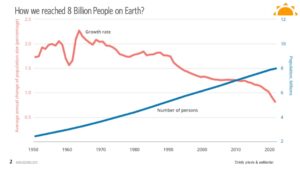Introduction
Recently, the World Health Organisation (WHO) played Beating the Retreat on Covid-19 and proclaimed that the global emergency on Covid is Over. The end tally of the Covid War Losses:
- 765,222,932 confirmed cases;
- 6,921,614 deaths;
- Glaring short comings of healthcare infrastructure;
- Economic and social disruption:
- Nearly half of the world’s 3.3 billion global workforce are at risk of losing their livelihoods, pushing nearly 0.82 billion into extreme poverty
- 25% increase in prevalence of anxiety and depression worldwide, affecting the mental health and well-being of people of all ages.
- Entire food system is affected due to weather changes and disruptions in the supply chains, reducing access to healthy, safe and diverse diets.
While the post Covid war reparations are underway, there was another bugle on the population front. Last year we added the 8th billion human on earth. This is going to be another pandemic in the waiting. The healthcare needs for 8 billion people is a horror war movie in the making. Closer home, India is going to be the most populated country in the world next year.
The Demographics of Population Pandemic
Global Population Pandemic
As a thumb rule, global population growth will stabilize when the birth rate and the death rate are equal. We will continue to grow till the fertility rate ie. the number of children born per woman falls below 2.1. As per various scenarios, the world population, currently around 8 billion, is expected to reach 9.8 billion in 2050 and 11.2 billion in 2100, and then decline gradually.

India’s Population Pandemic
India’s population is expected to peak at 1.65 billion by 2060 and then decline gradually. According to reports woman fertility rate falls below 2.1 by 2030. India’s demographic transition from a high-fertility and high-mortality society to a low-fertility and low-mortality society. (From 2.33 children per woman in 2015 to 2.03 children per woman in 2021, while the life expectancy at birth has increased from 67.7 years in 2015 to 69.4 years in 2021. The population pyramid also shows that the number of children under 15 years old peaked in 2011 and has been declining since then, while the number of elderly above 65 years old has been increasing steadily. Also read: According to a report by The Times of India, India’s population will stabilize only in 2050 (2047 is our Amrit Kaal Amrit Kaal : Budget 2022 | Kapil Khandelwal KK) when the death and birth rate will be balanced. Also we have a higher than usual healthcare acuity due to our genetic make up Tedx Archives | Kapil Khandelwal KK
Managing India Population Pandemic, Its About Quality of Life and Health
For the Covid pandemic, India quickly ramped up the production of Covid Vaccine and also played the vaccine diplomacy. Over billion doses of Covid vaccine was supplied globally to different countries apart from immunising billion Indians. India has built global scale capacity for facing the pandemics. India is also looking to champion the agenda of healthcare for the Global South in its Chairmanship for the G-20 this year. But the issue around the demographics of the population pandemic goes beyond providing for healthcare.
As we plan ahead for the Amrit Kaal 2047 when India’s population growth stabilises, I have been writing and speaking on what is required. Let’s use the Roti, Kapda, Makaan, Dava-Daru (the last one is already addressed in my Tedx Talk Read Healthcare For All | Kapil Khandelwal KK)
- Food security: We have to feed 1.6 billion mouths by 2047 two square mealsx365 days a year. We don’t have enough land mass to be able to produce food at that large quantum. Intensive, industrial scale agriculture would have to be introduced with Green Revolution 2.0. (see PM Task Force Report on Food and Agri Reform Food And Agri Reforms | Kapil Khandelwal KK)
- Water Scarcity: For sustaining life, we had addressed linking of north rivers to south rivers and regenerating the water table
- Sustainable Smart Cities: by 2047 over 60% of the population will be urbanized and would need sustainable and healthy living environment on a very concentrated urban land mass with lower levels of pollution.
- Healthcare for All: We urgently need to invest USD 360 billion to come up to global standards on healthcare metrics. In addition, another USD 675 billion in the healthcare and life sciences value chain to sustain our current and future population and the health acuity today.
Let’s live and let live in a world that can sustain this population pandemic!
Assisted by ChatGPT 😉
Also See Presentations
Also Listen to Podcast



